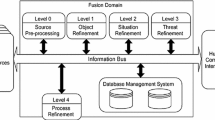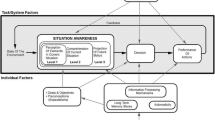Abstract
Situation Awareness (SA) is the problem of comprehending elements of an environment within a volume of time and space. It is a crucial factor in decision-making in dynamic environments. Current SA systems support the collection, filtering and presentation of data from different sources very well, and typically also some form of low-level data fusion and analysis, e.g., recognizing patterns over time. However, a still open research challenge is to build systems that support higher-level information fusion, viz., to integrate domain specific knowledge and automatically draw conclusions that would otherwise remain hidden or would have to be drawn by a human operator. To address this challenge, we have developed a novel system architecture that emphasizes the rôle of formal logic and automated theorem provers in its main components. Additionally, it features controlled natural language for operator I/O. It offers three logical languages to adequately model different aspects of the domain. This allows to build SA systems in a more declarative way than is possible with current approaches. From an automated reasoning perspective, the main challenges lay in combining (existing) automated reasoning techniques, from low-level data fusion of time-stamped data to semantic analysis and alert generation that is based on linear temporal logic. The system has been implemented and interfaces with Google-Earth to visualize the dynamics of situations and system output. It has been successfully tested on realistic data, but in this paper we focus on the system architecture and in particular on the interplay of the different reasoning components.
Preview
Unable to display preview. Download preview PDF.
Similar content being viewed by others
References
Baader, F., Calvanese, D., McGuinness, D.L., Nardi, D., Patel-Schneider, P.F. (eds.): The Description Logic Handbook: Theory, Implementation, and Applications. Cambridge University Press, Cambridge (2003)
Baumgartner, P., Furbach, U., Pelzer, B.: Hyper tableaux with equality. In: Pfenning, F. (ed.) CADE 2007. LNCS, vol. 4603, pp. 492–507. Springer, Heidelberg (2007)
Baader, F., Ghilardi, S., Lutz, C.: LTL over description logic axioms. In: Brewka, G., Lang, J. (eds.) Procs. KR 2008. AAAI Press, Menlo Park (2008)
Blasch, E., Kadar, I., Salerno, J., Kokar, M.M., Das, S., Powell, G.M., Corkill, D.D., Ruspini, E.H.: Issues and challenges in situation assessment (level 2 fusion). Journal of Advances in Information Fusion 1(2), 122–139 (2006)
Bauer, A., Leucker, M., Schallhart, C.: Monitoring of real-time properties. In: Arun-Kumar, S., Garg, N. (eds.) FSTTCS 2006. LNCS, vol. 4337, pp. 260–272. Springer, Heidelberg (2006)
Endsley, M.R.: Towards a theory of situation awareness in dynamic systems. Human Factors 37, 32 (1995)
Fuchs, N.E., Kaljurand, K., Kuhn, T.: Attempto Controlled English for Knowledge Representation. In: Baroglio, C., Bonatti, P.A., Małuszyński, J., Marchiori, M., Polleres, A., Schaffert, S. (eds.) Reasoning Web. LNCS, vol. 5224, pp. 104–124. Springer, Heidelberg (2008)
Gabaldon, A.: Compiling control knowledge into preconditions for planning in the situation calculus. In: Procs. IJCAI 2003, Acapulco, Mexico (2003)
Ghanea-Hercock, R.A., Gelenbe, E., Jennings, N.R., Smith, O., Allsopp, D.N., Healing, A., Duman, H., Sparks, S., Karunatillake, N.C., Vytelingum, P.: Hyperion—next-generation battlespace information services. The Computer Journal 50(6), 632–645 (2007)
Haarslev, V., Möller, R.: Racer: A core inference engine for the semantic web. In: Fensel, D., Sycara, K.P., Mylopoulos, J. (eds.) ISWC 2003. LNCS, vol. 2870. Springer, Heidelberg (2003)
Matheus, C.J., Kokar, M.M., Letkowski, J.J., Call, C., Baclawski, K., Hinman, M., Salerno, J., Boulware, D.: Lessons learned from developing SAWA: A situation awareness assistant. In: FUSION 2005: 7th International Conference on Information Fusion. IEEE, Los Alamitos (2005)
Nowak, C., Lambert, D.: The semantic challenge for situation assessments. In: 8th International Conference on Information Fusion, July 2005. IEEE, Los Alamitos (2005)
Parsons, T.: Events in the Semantics of English: A Study in Subatomic Semantics. MIT Press, Cambridge (1994)
Pnueli, A.: The temporal logic of programs. In: FOCS, pp. 46–57. IEEE, Los Alamitos (1977)
Pelzer, B., Wernhard, C.: System description: E- kRHyper. In: Pfenning, F. (ed.) CADE 2007. LNCS, vol. 4603, pp. 508–513. Springer, Heidelberg (2007)
Raschid, L.: A semantics for a class of stratified production system programs. Journal of Logic Programming 21(1), 31–57 (1994)
Smart, P.R., Russell, A., Shadbolt, N.R., Shraefel, M.C., Aktivesa, L.A.C.: A technical demonstrator system for enhanced situation awareness. The Computer Journal 50(6), 704–716 (2007)
Sutcliffe, G., Suttner, C.B.: The TPTP Problem Library: CNF Release v1.2.1. Journal of Automated Reasoning 21(2), 177–203 (1998)
Schwitter, R., Tilbrook, M.: Meaningful Web Annotations for Humans and Machines using Controlled Natural Language. Expert Systems 25(3), 253–267 (2008)
Author information
Authors and Affiliations
Editor information
Editors and Affiliations
Rights and permissions
Copyright information
© 2009 Springer-Verlag Berlin Heidelberg
About this paper
Cite this paper
Baader, F. et al. (2009). A Novel Architecture for Situation Awareness Systems. In: Giese, M., Waaler, A. (eds) Automated Reasoning with Analytic Tableaux and Related Methods. TABLEAUX 2009. Lecture Notes in Computer Science(), vol 5607. Springer, Berlin, Heidelberg. https://doi.org/10.1007/978-3-642-02716-1_7
Download citation
DOI: https://doi.org/10.1007/978-3-642-02716-1_7
Publisher Name: Springer, Berlin, Heidelberg
Print ISBN: 978-3-642-02715-4
Online ISBN: 978-3-642-02716-1
eBook Packages: Computer ScienceComputer Science (R0)




